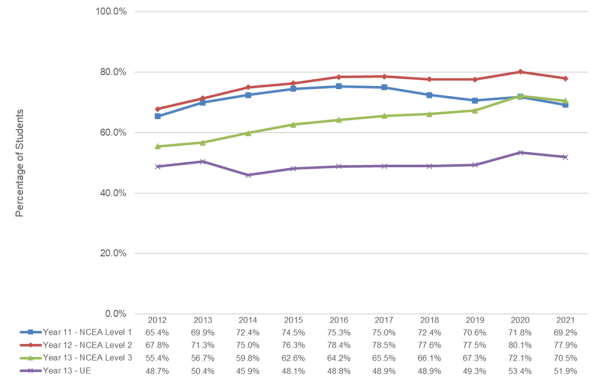The New Zealand Qualifications Authority (NZQA) has released finalised attainment data from 2021, showing attainment of NCEA and University Entrance is slightly lower than 2020, but similar or higher than in 2019.
Secondary Statistics Consolidated Data Files for 2021
“Hard work by students and outstanding support from schools has paid off, complemented by changes to NCEA which helped address the disruption from COVID-19,” says NZQA Deputy Chief Executive Assessment, Andrea Gray.
Level 1
Overall attainment of NCEA Level 1 amongst Year 11 students was 69% in 2021, compared to 72% in 2020 and 71% in 2019.
“Year 11 NCEA Level 1 attainment has been decreasing steadily since 2017, except for a slight increase between 2019 and 2020. This is consistent with a trend of some schools moving away from offering a full NCEA Level 1 programme in Year 11, focussing instead on a two-year pathway to achieving NCEA Level 2 in Year 12,” Ms Gray says.
Levels 2 and 3
Attainment of NCEA Level 2 amongst Year 12 students decreased by 2.2 percentage points from 2020 (an increase of 0.4 percentage points compared to 2019); while attainment of Level 3 in Year 13 declined by 1.6 percentage points from 2020 (an increase of 3.2 percentage points compared to 2019).
“Students and schools were generally well supported by the interventions put in place, which included changes to exam and portfolio submission dates, Learning Recognition Credits and – for the most affected students – access to Unexpected Event Grades and adjustments to UE and endorsement thresholds,” Ms Gray says.
“At NCEA Level 2 and above, average levels of attainment were higher in 2021 than in 2019 across all decile bands and amongst each ethnic group, with the exception of a net 0.6 percentage point drop amongst Māori Year 12 students working towards NCEA Level 2.”
Equity
“Addressing barriers to equitable attainment continues to be a priority for NZQA, especially for Māori and Pacific students, those from low socio-economic backgrounds, and students with disabilities or special learning needs,” Ms Gray says.
While attainment for Māori and Pacific students has held up during 2021 compared with 2019, the underlying equity gap remains.
“There continues to be a significant differential between Māori and Pacific students and their European or Asian peers. NZQA will soon release a paper examining conditions that contribute to this,” Ms Gray says.

NZQA continues to analyse data from 2021 and anticipates releasing its Annual Report on NCEA and New Zealand Scholarship Data and Statistics in June 2022.

